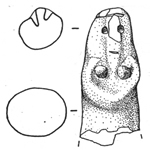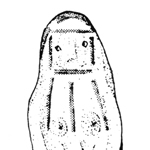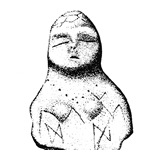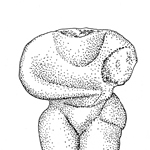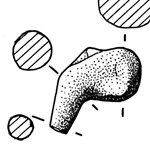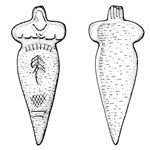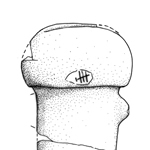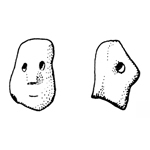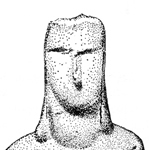| |
|
|
Female Neolithic Clay Figurines from Italy
Iconography and Cultural Context
Maria
Antonietta Fugazzola Delpino- Vincenzo Tiné
(translated from Bullettino di Paletnologia Italiana, 93-94. 2002-2003,
19-51)
Current state of the topic and a possible typological approach
The debate on small Neolithic figurines from Italy does not seem
to have reached great advancement since the strong interest witnessed
in
our country in the 70’s and 80’s. This interest was brought
up by important research projects on cult archaeology led by authors
such as M. Gimbutas (GIMBUTAS 1982) and C. Renfrew (RENFREW 1985).
Only one real attempt to systematize this category of objects, even
though limited to the Neolithic figurines from the Po Valley, was carried
out in 1978 by B. Bagolini (BAGOLINI 1978). Therefore, most of the finds
from the Italian Peninsula are only known through small descriptions
in archaeological articles lacking a specific iconographic and stylistic
approach. A systematic catalogue of the archaeological finds, characterized
by a standard approach of description that would provide a well-structured
and complete background of the data, is the only way to solve the current
state of affairs and enable an effective synthesis of the archaeological
situation. While waiting for the proper conditions to create this wide
range academic project we believe that it is useful to provide the debate
with some preliminary and general interpretative ideas especially focused
on the definition of iconographical models as unique characteristics
of spatial and cultural aspects.
A specific typological approach uniquely based on the distinction between
schematic and naturalistic typologies, would not be useful within a
comprehensive study characterized by the widest range of conventions
within the same facies, and even within the same typology of figurines
usually defined by both schematic and naturalistic elements. A wider
correspondence to the features of this group of images could be determined
on the distinction between bi-dimensional and tri-dimensional or volumetric
figurines. Therefore between those figurines carved with an emphasis
on the frontal axis and those modelled focusing on a larger spatial
context. It has been noted, however, that a preference for detail on
the front axis is also present on more articulated figurines, the generalizations
of these categories does not provide, in this case, the necessary tools
for specific distinctions, only the definition of a secondary characteristic.
It is only through a more specific approach focused on the characterization
of precise iconographic aspects, and not only the typological and stylistic
details, that it is possible to create a new interpretation of Neolithic
female figurines from the Italian Peninsula. The definition of the
iconographic
details can not just be linked to a systematic use of complex structural
models (typology), the attitude of the figurine (posture) and the stereotypes
used in the modelling of the different body scheme (anatomical
schematization; figure 1), but also on the recurrent emphasis on
specific anatomical parts (especially sexual) or accessories. Due to
the fact that iconography is more or less linked to the material culture
that creates it, its interpretation has to be contextualized. The determination
of common iconographic models within a specific cultural reality, is,
in our opinion, one of the most important indications of the symbolic
significance and the use of this particular category of objects.
Iconographic
aspects within cultural contexts
The female figurines recovered from the settlements of Rendina, in
the valley of Ofanto, in Basilicata (Figure
2; CIPOLLONI 1977-82) and from Favella in the Sybari Plain, Calabria
(Figure
3.1; ed. by TINE V., 1996) date back to the oldest phase of the
Neolithic Period in the Italian Peninsula, characterized in southern
Italy by the Archaic Impressed Ware.
Only fragments of these figurines were recovered during the archaeological
investigation but it is still possible to determine the features of
a stylized conical-shaped upper part of the body and an extremely naturalistic
detailed lower part. In this lower portion of the figurine the emphasis
is focused on the pelvic area - characterized by a large space delimiting
the pubic hair region, represented by dots or hatchings and that includes
a relief carved vulva – as well as the buttocks protruding but
not steatopygic. The head might have been totally without facial features
as suggested by the truncated cone-shaped torso as well as by the hypothetical
cephalic cusps recovered not associated to the finds from Favella.
The
posture of the modelled figurine is seated, as clearly visible in the
figurine from Rendina and only imaginable through the lower part of
the body recovered at Favella: a posture that can be interpreted as
the process of giving birth as suggested by the dilation of the vulva.
The structure and the seated posture of the figurine may be associated
to a cylindrical bust as in the female seated figurine recovered at
Vinca (GIMBUTAS 1982, Fig. 2.2).
Similar to this typology of figurine, finely characterized in its essential
lines and that therefore seems to suggest a precise iconographic choice
within the facies, is a find recently recovered at Favella (figure
3,
TINÉ V. in AA.VV. 2001): the recovery consists in a large fragment
and other possible ones, which can not be pieced together, of a figurine
of considerable dimensions (height 13 cm; width 10 cm). In this case
the portion recovered is the torso, with the exception of the upper
part, the lower limbs and the whole rear side (as well as the buttocks).
What is left of the figurine is more than enough to associate it to
the other Archaic Impressed Ware Phase figurines from southern Italy.
The difference is however considerable in regard to the size of the
object and its standing posture, as suggested by the left leg fragments
(similar to the figurines smaller in size is the focus on the pubic
region of the body and the cylindrical structure). The standing posture
and the difference in size may suggest a different use of the image,
and may have been a proper cult image (possibly planned for a wider
use than just in a personal or family context).
The context of use of the figurines from Favella and Rendina are always
linked to a domestic environment, since all three finds were recovered
within dwelling-places. The fact that the figurines were recovered in
ditches filled with inhabitation structural elements and other materials
from domestic environments, suggests a link between the fragmentary
figurines from Favella (possibly intentionally fragmented as in the
case of Endrod) and the abandonment phase of the original domestic structures.
The naturalistic details of the middle part of the body, the buttocks
and the genital area, and the more schematic upper part of the figurines
seem to be an intentional fusion between the emphasized female details
and the sexual ambiguity of the object’s shape. The shape of the
hips and the torso in the figurines from Favella and Rendina clearly
reflects a masculine representation; this can be seen clearly in the
larger size figurine in which the fairing of the buttocks protrude to
the front of the object resembling testicles rather than female hips.
The highlighted detail of the enlarged pubic triangle might be a reference
to the archetypal principle of the “Great Mother’s Womb”
or to the “Lap of the Sub-terranean Queen”, identified by
Neumann, Diterich and Eliade and used by Gimbutas in an interpretation
of the agrarian context in the “sown wombs”, associated
to the androgynous aspects of the phallic upper parts of the body (GIMBUTAS
1982, 196). The link between the fertility of the fields and the fertility
of the woman is quite explicit in the representation of the pubic region
with dots or dashes as a cultivated field, along a symbolic pattern
that would be the naturalistic introduction to the “quasi-hydeogram” of
the Pregnant Vegetation Goddess, identified by Gimbutas (ibid., 201,205;
1990, 145) in the Balkan motif of the dot in the lozenge.
Most of the characteristics described so far seem to associate the earliest
Neolithic female figurines from south of Italy to the figurines dating
back to the early phases of Mediterranean and east-European Neolithic
Period. In these regions the emphasis was focused on the naturalistic
representation of the genital areas of the body and therefore on the
concepts of fertility and fecundity. Many of the earliest Neolithic
Period figurines from the Mediterranean region are also characterized
by the hybrid representation of female and male features, as in the
unitarian myth of the Huroborous (cfr. CAUVIN 1987).
Two figurine fragments recovered at the sites of Casa Soverito (NICOLETTI
1992, fig 2, 58: figure 5) and from Capo Alfiere near Crotone (MORTER
1992, 211), can be attributed to a facies of Stentinello in the later
phase of the Upper Neolithic Period in Calabria. The find from Casa
Soverito, that was in a better state of preservation, follows a similar
naturalistic style present in the figurine from Favella, with the same
emphasis on the pubic region – in this case in bas-relief – but
with a more detailed carving of the upper part of the torso.
Also in Calabria, but part of a northern facies called Cassano Style,
was recovered a vase handle from the cremati layer in the Grotta Pavolella.
The object is considered in this study because shaped with female features
(figura 6; CARANCINI-GUERZONI 1987, 788-89, fig. 3, 10). A marked realism
is evident in the features of the handle, carved on all sides, and
in
the use of colour to highlight physical details and clothing accessories.
The Late phases of the Neolithic Period in Calabria are therefore characterized
by a more articulated elaboration of the anatomical features not only
focused on the symbolic emphasis of female elements, which are however
still important. More extensive research is required for the interpretation
of Neolithic Period female figurines, of the painted ware phase, from
the Tavoliere region in Apulia. Research that follows the guide lines
traced by M. Gimbutas on the interpretation of the symbolic “metalanguage”
of figurines, their features and ornaments. The most famous Apulian
figurines were recovered at Passo di Corvo (figure 7-8; TINE S. 1983,
ill. X-XI). They denote a homogeneous iconographic and stylistic pattern:
the upper part of two figurines of a schematic typology were recovered,
with small breasts and triangular-shaped heads linked to the torso.
Hypothetically attributed, by those who found them, to the two main
inhabitation phases of the site (facies Masseria La Quercia fig. 6 and
facies Passo di Corvo fig. 7) they could suggest a continuity in the
iconographic model also noticeable in a figurine recently recovered
at Canne, unfortunately unstratified (fig. 9; RADINA 1997). The geometrical
structure, the small breasts, the head slightly tilted backwards in
a ‘hieratic’ manner (TINE 1983) and the facial details
resemble the ones from Passo di Corvo especially from the Passo di
Corvo facies.
The bell shape features of the figurine seem to be dictated by static
reasons rather than expressive ones: like the other objects the representation
refers to a schematic female figure with a sub-triangular rather than
sub-elliptical structure of the torso, cut horizontally in the pubic
area. The sex is emphasized by diverging parallel lines and by a significant
lozenge motif (tree shaped or ear of corn shaped), evocative of the
recurrent motif of Vulva and Birth, remarkably similar to the famous
bone figurine from Riparo del Gaban.
Particularly important are the marks that can be found on the bodies
of all figurines from the Tavoliere region and the interpretation of
their message. As clearly noticeable on the figurine from Canne these
marks can not be simply defined as decorative or as clothing elements.
M. Gimbutas (GIMBUTAS 1990) and S. Tiné (TINE S. 1983) had already
underlined the symbolic importance of the “zig-zag/grass snake”
motif and the “hour glass/butterfly” motif on the more elaborate
figurine from Passo di Corvo. Motifs interpreted by the scholars as
linked to water, an element generally associated to a source of life
and therefore one of the main aspects of the Goddess. This symbolism
is even more evident in the figurine from Canne: the large “sun
shaped” circular motifs near the breasts and kidneys, with the
repeated sequence of double marks (the importance of the repetition
has been widely discussed by M. Gimbutas in reference to finds from
the Balkan region; GIMBUTAS 1982), and especially in the tree shaped
motif present near the vulva clearly linked to human and plant fertility
radiating from the Earth-Goddess’ womb.
The small idol from Montocchio (Cremonesi e Bianco in AA. VV., no date
available, fig. 10) may also be placed in this category of schematic
figurines with symbolic elements. The object is a simple clay cylinder
with a lower appendix interpreted as feet and with gaps in the areas
of the head and arms (head and arms were possibly added on); an extensive
decoration of horizontal and ‘zig-zag’ marks decorated
in vertical strips the whole surface of the body. The possibility that
the decoration is applied through graffiti instead of incisions and
the (confused) association with graffiti decorated ware, as well as
with evolved typologies of impressed techniques, may link the object
to the Graffito Ware facies contemporary to the painted ware of the
Middle Neolithic Period in the Tavoliere region. Ware on which are
concentrated
these kinds of representations with explicit symbolic value linked
to the graffiti that cover the whole body rather than specific regions.
A substantially smaller number of female figurines from the Neolithic
Period have been recovered in central Italy compared to the southern
part of the peninsula.
The only examples of female clay figurines dating back to the Early
Neolithic Period in the eastern region of Central Italy were recovered
at the site of Ripabianca di Monterado (fig. 11; LOLLINI 1965) where
Adriatic impressed ware was also recovered. Three schematic female figurines
were found, with a simple rectangular body structure slightly expanded
on the shorter sides. The relatively early appearance of these styles
in the Adriatic northern-central region can be compared to the rise
of schematic typologies in pre-VBQ such as Fiorano and archaic VBQ such
as Ponte Ghiara. On the grounds of the absolute dating (around 6200
BP) and the recovery at the site of Ripabianca of depurated ware with
vertical handles, figurine ware and a pottery shard painted with red
strips it is possible to suggest a very long abruzzese-marchigiana facies
with a use of impressed ware until the late phases of the Early Neolithic
Period.
Another figurine was recovered at Catignano, a site that provides the
name for one of the Adriatic facies (fig. 12, TOZZI-ZAMAGNI 2000-2001).
This figurine is quite different from the other contemporary ones from
the painted ware phases of southern Italy; the figurine is completely
cylindrical in shape instead of flat or convex as in the figurines
from
Passo di Corvo. This characteristic is also different if compared to
finds from the northern Adriatic and sub-Adriatic area such as Ripabianca
di Monterado and Sammardenchia. A further difference between these
objects
is the marked rastremation of the upper chest area along a pattern
impossible to associate – even replacing the lost arms – to
a sub-rectangular typology slightly expanded on the shorter sides.
From a stylistic point
of view these differences seem to suggest a fusion with typologies
common to northern-central Adriatic area, even though there are some
similarities
between the figurine from Catignano and other figurines from southern
Italy such as the use of symbolic motifs, carved or as graffiti, in
this specific case represented by a V.
Among the typology of seated female figurines crafted in a rough manner
can also be included a find recently recovered at Sesto Fiorentino (Sarti
in AA. VV. 2001; fig. 13) in the Tyrrhenian area, along with the fragment
of a figurine possibly referable to a seated posture but crafted in
a more realistic fashion. The chronological table of the figurines from
Sesto Fiorentino, fixed through cultural association to the VBQ phase,
may date the spread of this typology of seated figurines, more or less
stylized or realistic, back to the apex of the main cultural koine of
the Neolithic Period in the north: it is within this cultural area that
are found the prototypes of this typology of figurines that because
of its geographical extension and stylistic homogeneity may again suggest
the willingness to use a consolidated cult iconography.
At Poggio Olivastro (fig. 14), in the Latium northen area, has recently
been recovered a, clearly volumetric and at the same time abstract
figurine
lacking anatomical details: what has survived is the lower portion
of a seated figurine with flat buttocks and the feet slightly set apart.
The emphasis is set on the seated posture of the figurine and on the
central part of the body, but lacking any kind of sexual details. The
archaeological layer in which it was recovered seems to present finds
dating back to the Late Middle Neolithic Period (with the tubular handles
resembling Serra d’Alto and with tree coloured ware). On the
missing torso and head it is very difficult to advance suggestions:
a comparison
with similar typologies of seated female figurines may suggest a sub-elliptical
or bidimensional schematization.
A figurine with completely different characteristics was recovered
during archaeological investigation at the site of Tufarelle di Allumiere
in
the Monti della Tolfa, in the Latium region(fig. 15). At the site a
settlement built on terraces along the side of a hill was discovered,
inhabited, without continuity, between the Early Neolithic Period –
impressed ware, Cardial ware and Red Bands painted ware – up
to the middle of the Bronze Age. The chronological-cultural interpretation
of the object is only possible through style comparison because the
object was recovered within an archeologically mixed layer full of
materials
from different Pre-historic and Proto-historic phases. Because of its
bi-dimensional schematization the figurine can be associated to the
Early Neolithic one unearthed at Ripabianca di Monterado, but it presents
some peculiarities such as upper and lower gaps, probably used to anchor,
through the use of wooden pins, the lower limbs and the head or to
fix
the object to some sort of base. Composite elements were used already
from the early phases of European Neolithic Period and as attested
by
the Koros di Endrod 39 context, have an important cult role in the
practice of dismantling the figurine and the redeposition of the parts
within
a votive pit: the possibility that this was a figurine with head and
limbs made out of wood, or stone, would suggest a link with the objects
characteristic of the Calcolithic facies of Rachmani in Tessaglia.
The
current archaeological information regarding northern Italy unfortunately
lacks any kind of evidence of figurines within the Impressed Ware facies
from Liguria. This gap makes it impossible for scholars to suggest a
cultural correlation with the contemporary peninsular facies of the
Early Neolithic Period and especially with the figurines from southern
Italy.
The Neolithic Period cultural groups present in the area of the Po
Valley and the Alps – Gaban, Vhò and Fiorano – are
carefully characterized under the aspect of figurative expressions,
within each
cultural aspect, referable to a specific iconographic option with a
related typological pattern solution.
Considerations that emphasize the Mesolithic role in the Gaban Group
have been elaborated on the grounds of some elements interpreted as
traditional both in the lithic assemblage as well as in the ornaments
(BAGOLINI 1980). Along this interpretative approach the conservative
aspects of the Gaban Group find confirmation in the persistent use
of “Paleolithic type” figurative options in the Castelnoviana
and Proto-Neolithic phases.
As well as two female figurines, carved on a bone shard and a sus tooth
(fig. 16-17, BAGOLINI 1980), there are even more problematic antropomorphic
representations on a pebble and diaphysis of a human thigh-bone. The “archaic” appearence, of the first two objects, may have
been dictated by the materials on which they were carved and therefore
by the limits associated to the rendering of the material (cd. Contours
decoupées). On the grounds of their style both these figurines
can be actually placed in the stylistic contexts of the following Square
Mouthed Pottery phase, in the typology defined by B. Bagolini: “figuretta
con torso a gruccia” (figurine with coat-hanger shaped bust) especially
the ones “with the arms to the breast” (therefore according
to the terminology suggested in this article as sub-elliptical torso
schematization). In both figurines there is a clear the emphasis on
the genitalia, expressed through the deep mark of the vulva positioned
at the centre of the prospective.
In the figurine carved on the bone shard the lower part is carved in
a pubic shape and the vulva is surmounted by a specific tree-shaped
motif. As this emphasis constitutes, without doubt, a recurrent motif
already in the Paleolithic Period, since the earliest incised art expressions
from Aurignatian Dordogne, but it also seems to be one of the main-motifs
of the earliest Mediterranean Neolithic representations, because of
the emphasis of the hips. Detail that is recurrently found in the figurines
from the Gaban culture. The presence of the tree-motif, interpreted
by Gimbutas(GIMBUTAS 1990, 102) and later also by Guilaine (GUILAINE
1994, 390) as a symbol of vegetal rebirth from the womb of the earth,
strengthen the Neolithic characterization of this representation, that
has to be linked to agrarian fertility. Along the same theory it could
also be important the presence of red ochre in the lower part of the
body, hypothetically intended to be fixed into the ground.
During the Early Neolithic Period a cultural group, from the north
of the peninsula, with specific characteristics regarding female representation
is the Piadena’s Vhò Group. A cultural horyzon that expanded
throughout the whole Po Valley region. A group of “mushroom shaped
head” clay figurines moulded with elaborate hairstyle, roughly
modelled arms, buttocks emphasized in contrast to the flat-convex structure
of the body and cylindric shaped lower limbs with expanded base was
recovered at the sites of Campo Ceresole and San Lorenzo Guazzone (figure
18-19; BAGOLINI-BIAGI 1977, AA.VV. 2001). It is important to specify
that it is, stylistically a very homogeneous group of figurines and
clearly characterized in their iconography. The same typology as in
the Vhò Group is also attested (in the contemporary and similar
in style to the Alba Group) in other areas of the Po Valley. A fragment
of figurine traceable back to a “mushroom” shaped style
(one of the fragments from the Alba group) (figure 20; VENTURINO GAMBARI
1992) is especially interesting not only because of its good state
of
conservation, important for comparison, but also because of an ornate
chevron decoration derived from the characteristic motifs present on
the ware from Alba and therefore attesting the local production of
the
figurine.
A less particular typology, but equally homogeneous, is attested by
the group of figurines uncovered at the site of Sammardenchia (fig.
21; Pessina AA.VV 2001) referable to the contemporary group of Fagnigola-Sammardenchia
from the Friuli region. Rather than defining the 5 figurines as schematic – definition that would imply an intentional abstraction –
they appear only slightly naturalistic because of a rough crafting technique;
the female characterization of the figurine is rendered by the breasts,
the size of the hips and the emphasis of the sex through the opening
of the lower limbs. The roughness of the upper limbs is common in the
stereotype of many volumetric figurines (sub-rectangular with upper
and lower expansions). An intentional sexual ambiguity is clear in the
figurine’s head shaped as a simple flat protuberance. Particularly
interesting within this group of objects from Friuli, and absolutely
unique in the Italian Neolithic Period, is the figurine “with
a bundle in its arms” (fig. 22; Pessina AA.VV. 2001) that has
been interpreted as a kourotrophos. A similar schematic typology of
representation, bidimensional as in most Neolithic Period figurines
from the Pianura Padana, but with a sub-elliptical shaped torso, can
be noticed in the female figurines of the cultural facies from Fiorano
del Veneto and the region of Emilia (BAGOLINI 1980, 179). This correspondence
is attested in the famous figurine which presents holes positioned in
the area of the roughly modelled arms recovered during archaeological
investigation at the site of Chierici ad Albinea or at Rivaltella (Gaggia
in BAGOLINI 1978). A fragment of “torso a gruccia” recovered
at Chiozza may be referable to this same typology and to the same cultural
group (Fiorano Group).
It seems more logical to interpret the fragments of limbs with expanded
terminations, recovered at Rivaltella (Gaggia in BAGOLINI 1978), as
possible influences or exchanges with the Vhò culture and subsequent
reception of iconographies in an archaic phase of the VBQ rather than
interpreting it as an association to the “torso a gruccia”
typology. The same theory can be applied to the recent amazing recovery
of 75 fragments of female figurines at Ponte Ghiara near Salso Maggiore
in Emilia (fig. 23-24; BERNABO BREA M. et. al. 2000). Within this group
of objects there are several elements attributable to “torso a
gruccia” female figurines (sub-elliptical schematization), cylindrical
shaped head with nose in relief and seated posture, similar to the VBQ
from Liguria, along with expanded termination fragments and mushroom
shaped heads similar to the figurines common in the Vhò group.
The first kind of typology is mainly made up of lower body fragments
with the limbs fused together into one curved appendix. This characteristic
can be found in two variations modelled on all sides or flat (one side
modelled the other one flat) it is therefore possible to highlight,
in the Early Neolithic Period cultural groups from the north of Italy
preceding the VBQ koine, peculiar figurative elements that are not lacking,
with the exception of the Vhò Group, a common stylistic ground
that will fully evolve in the following phase. From the stylistic point
of view it can already be noticed, in this phase, a common use of torso
representation, a tendency to model anatomical features only on one
side, probably induced by a bi-dimensional concept of view that tends
to flatten the object.
Apart from the schematic representation of the figurine it is also
evident a willingness to emphasize female sexual details, especially
(as in
the Vhò Culture) the genitalia area and the hips, while the
breasts are only slightly modelled. The head always lacks details,
sometimes
only represented as a truncated cone appendix, more or less expression
of a sexual ambiguity.
A typology of female representation with unified characteristics such
as the Geometric-Linear Style of the Square Mouthed Pottery initial
phase is attested during the Middle Neolithic Period in the Po Valley.
The core can be traced to the Liguria area, as suggested by the abundance
of finds (BERNABO BREA L. 1946; 1956; TINE S. 1975; 1999) as well as
their precocity. A figurine’s head with a projecting nose (TINE
S. 1999, fig. 165) that can be attributed to a transitional typology
from the VBQ, also present in a fragment from Quinzano Veronese (BIAGI
1974, fig. 18) was recovered from layer XIII of the Arene Candide.
This
level is characterized by the Pollera Style of graffited wares, that
is probably the starting point of the Square Mouthed Potteries and
that
attest significant connections with the situation in Fiorano.
The two typologies elaborated by Bagolini (BAGOLINI 1978) regarding
this series of objects are “figurines with coat-hanger shaped
bust” therefore with atrophic arms and flat bust (sub-elliptical
schematization using the terminology suggested in this article) and
“figurines with arms to the breast and loose hair” (fig
25-26 TINE S. 1975; 1999). These two varieties, however, seem very hybrid
especially because of the lack of complete figurines. A recent find
from Grotta del Varè of a “torso a gruccia” figurine
with its surviving head (Fig. 27; ODETTI 1992)that attests the evolution
or hybrid aspect between the two stylistic solutions (but in this case
the hair does not fall on the shoulders but is instead held in a sort
of chignon) is further evidence of a substantial identity of the two
typologies. Even the difficulty in differentiating the two supposed
variations on the grounds of the find’s topographical and stratygraphic
origin appears symptomatic of their substantial homogeneity regarding
iconography. The figurine’s heads are usually “cylindrical” in
shape disregarding of the hairstyle fashion; the facial details (nose
and eyes, some times with marked eyebrows) are not very evident.
Little is known regarding the modelling of the lower part of the body;
a chance discovered find recovered in the Pollera Cave is modelled in
a seated posture with its legs crossed, as in a yoga position, while
lower body fragments recovered at the Arene Candide Cave are modelled
in a seated posture with flexed legs, the most probable posture for
this kind of figurines.
On the grounds of these elements it seems important to underline the
common aspects that link all of these VBQ figurines, that can be placed
to one generic schematic typology, characterized by a sub-elliptical
dilatation of the upper body in spite of the modelling of the arms (atrophic
or bent under the breast) that can be interpreted as a stylistic secondary
element of the same iconographic model.
A different typology, but probably still within the VBQ phase might
be identified in a unique find recovered in the 800’s in the
Arene Candide Cave (fig. 15; BERNABO BREA L. 1946). This figurine is
modelled
with an elliptical head rather than cylindrical, and the shape of the
torso is not sub-elliptical but instead sub-rectangular, slightly expanded
in the lower part, with atrophic arms. So far there is no evidence
of
figurines from the following Late Neolithic Period in the Po Valley,
a period archaeologically characterized by widespread use of the Chassey-Lagozza
Ware. The lack of evidence of female figurines in the Western Neolithic
world seems to suggest that it was not really involved in the ideology
of the Great Mother rather than a lack of specific archaeological data.
From
iconography to ideology
In
this article, the authors have tried to underline, even though in a
very synthetic manner, the substantial uniformity, especially regarding
the iconography and frequently the stylistic point of view, of female
figurative representations within the main Italian Neolithic Period
cultural facies. Analysing the figurines within their cultural context
we can identify some typological series that seem to represent the characteristic
expression of the universal image of female... within the single cultures.
(cfr tab 1).
As regards the subject represented, a wide spread uniformity and a
repetition of the female representation within the single cultural
realities suggests
an ideological religious background based on a “female monoteism”.
The whole group of Italian female figurines might then be interpreted
as a cult images repertory. To be more specific, these figurines were
probably used by individuals or families - as suggested by the frequent
recovery within domestic structures - and not by collective groups
(as
in the case of Paleolithic Period burials in cult grottoes).
As from the stylistic point of view we can still agree - in general
terms - with the conclusions expressed by Graziosi (GRAZIOSI 1973): “the eclecticism and the apparent incoherence of a kind of Italian
post-Paleolithic art manifestation, within their natural context, may
derive from the flow, in different periods, in our Peninsula, of cultural
elements of different origins and of the succession and differentiation
of many civilizations. This certainly did not help the melting between
the different art expressions and their diffusion through out a large
geographical area and a wide span of time”. The use of specific
stylistic models can be found at a particular location and time period,
and especially in the context of the cultural facies based on more selective
archaeological information (such as pottery and lithic assemblage).
As regards the iconographic repertory from Southern Italy the presence
of common styles in the following cultural facies in the region prevents
the authors from agreeing with the theories expressed by Cremonesi (in
BAGOLINI-CREMONESI 1987, 47): “the diversities of shapes and attitudes
fully justify, also for the Central and Southern areas of the Peninsula,
the refusal of simplistic theories linked to the Great Mother”
and “even if some unitarian currents can be identified in the
expression of art in Central and Southern regions of the Peninsula during
the Neolithic Period, these are limited to generalized themes, that
in their definite expression, reveal a wide variety and homogeneity
of shapes...” (ibidem, 49). On the contrary, a clear expressive
significance –in terms of function and fruition – of the
finds taken in to consideration is suggested by their link to a clear
iconographic model, within the specific cultural context.
Even clearer is the substantial uniformity of the female figurine model
in the Middle Neolithic Period in the Po Valley, a fundamental characterizing
element of the cultural unity of the Square Mouthed Pottery cultural
phase. The specificity of the figurative art characterizing each single
cultural group of the Early Neolithic Period in Northern Italy, instead,
underlines the independence and articulated complexity of these realities.
The gradual stylistic evolution of the female figurine representations
in the phases preceding SMP in the Emilia area (Fiorano and Archaic
SMP sites) and in Liguria (Ligurian Graffito Ware) seems to underline
an artistic cultural unification. This is in opposition to the theories
presented by Bagolini that emphasize the articulation represented by
the many “female stereotypes” within the SMP phase and defined
it as “proof of an articulate ideological patrimony in which female
representation of women takes on different meanings and more than one
distinctive role” (BAGOLINI-CREMONESI 1987, 42 quoting BAGOLINI
1978).
Rather than associating the totality of Italian finds regarding the
Neolithic Period female representations to “ a variety of magic-thaumaturgic
models, different from culture to culture and multivalent within their
context” (BAGOLINI 1978, 4), it seems more reasonable to associate
them to a conception, even if generalized, of “monotheism”
of the female deity, linked to the concept of fertility/fecundity –
therefore a concept of reproduction in a broad sense – expressed
in each single culture by a characteristic iconography, even though
with the obvious variations in style.
In conclusion it seems possible to perceive, as regards the articulated
repertory of the female representations in the Neolithic Period in
Italy,
specific iconographic models for the modelling of the female representation
and recognisable as characteristic of specific geographical and cultural
realities. These formal connections of individual cultural facies to
a wider iconographic pattern seems to suggest a narrow semantic context
for these clay representations. A context to which can still be adapted,
if bypassing an hypercritic tendency common in last few decades, the
old definitions of “Mother Earth” or “Great Mother.
This cult figurative expression through a female representation may
still be find confirmation in the classic definition by Neumann (NEUMANN
1981, 99) of Prehistoric representations of the Great Mother as: “representations
of the Goddess of fertility, pregnant, commonly considered woman of
birth and pregnancy... archetypal symbol of fertility and symbol of
the elemental, helping, protective, nourishing nature”.
Notes
1 Among the rare works on a national level GRAZIOSI 1973 (predominantly
anthological) and CREMONESI-BAGOLINI 1978 (short general considerations
surpassed by the current elements recovered from new sites). A
recent
exhibit of figurines, from the whole Italian Peninsula, held in the
Museo Nazionale Preistorico ed Etnografico “L. Pigorini”,
possible through loans from other museums, highlighted the of the archaeological
interpretation. Even though anthological rather than systematic, this
exhibit titled “Donne, uomini e animali. Oggetti d’arte
e di culto nella Preistoria” enabled the publication of a small
collective catalogue, unique in the fact that collects a series of
female
Neolithic figurines outside of their regional context. (AA. VV. 2001)
2
In this research project are not included figurines from Sardinia
and
Sicily because of their unique characteristics concerning the iconography
(very articulated in Sardinia, generally “bird shaped” and
non-female in Sicily), the context of recovery (also from burial
sites
in Sardinia in clear contrast to the use in the rest of the Peninsula)
and the material used (usually stone). All of these characteristics
limit any kind of typological schematization to a regional level.
3
For an approach from the point of view of the “context of fruition”,
archaeologically determined, in the works of JOICE 1996, cited
by Tine
V. In TINE S. And others, in press.
4
Are taken in to consideration only clay female figurines strictu sensu,
therefore representations of the whole human figure or at least the
significant portion; will be considered female all figurines characterized
by at least one anatomical detail, breasts or pubic triangle and/or
a marked steatopygy. These representations of the body and not just
of the head are the only ones that can be analysed according to complete
context, the posture of the figurine, essential for a correct iconographic
interpretation. On the grounds of these parameters even limited fragments
of torso or limbs are more valuable than elaborated and in perfect condition
heads. Are generally excluded from this research the many interesting
clay heads and other typologies of anthropomorphic representations,
not made out of clay, recovered during investigation of Italian Neolithic
Period contexts, especially from the south: these finds would be best
analysed in a separate study, avoiding general assimilations, that would
lack typology, iconographic and interpretative conclusions.
5
See MARANGOU 1996a for an interpretative model of the possible use of
figurines.
6
This motif seems also typical of the decorative repertory of many Italian
Neolithic cultural facies as Stentinello, Fiorano and Sasso Sarteano
and European within the Linear Band Keramik.
7
The analysis of the Sicilian figurines of the Stentinello phase,
from Uzzo Cave and Kronio Cave, characterized by a “bird shaped”
iconography and in some case non-female, is outside of this study (
regarding the problem of iconographic continuity-discontinuity with
the Paleolithic Period refer to the section Culti in TINE V., edited
by 1996). Its important to highlight the coherence of iconographic options
in the Sicilian Neolithic figurines than - actually different from the
rest of the Peninsula - seem to reflect the same reference to a lack
of random and everyday subjects. A suggestive reference might refer
to – with cautions – the birds represented in the cult images
of the Near East (CAUVIN 1997) and to the studies carried out by Gimbutas
on the “bird-goddess”.
8
F. Radina (RADINA 1992) instead interprets the motif incised at the
base of the figurine as a man in adoration, with horn shaped terminations
and with hands, represented to show the link between the divinity and
the offerer.
9
The figurine from Montocchio (Cremonesi and Bianco in AA. VV.)
might
be included in this highly symbolic characterized schematic series.
It is a simple clay cylinder with short appendix representing
the feet
and broken areas corresponding to the arms and head (possibly attached?);
the possibility that it is a graffito decoration rather than
incised
and the association to ceramic decorative elements made through this
technique, as well as through impression techniques, might locate
it
to a facies – the Graffito Ware Culture- substantially synchronous
to the Middle Neolithic period painted ware from the Tavoliere region,
where are common these representation with an explicit symbolic characteristic
through the use of graffiti that cover the whole body rather than a
specific articulation.
10
A tendency, also in the south-eastern area of the Peninsula,
towards
a more naturalistic approach – with the abandonment of the old
symbolic code linked to graphic symbols – might be suggested by
some female heads, recovered within Late Neolithic Period contexts in
Apulia. The finds from Grotta Pacelli (STRICCOLI 1988, fig. 48) and
from Cala Scizzo (GENIOLA-TUNZI 1980), refer to the Serra d’Alto
facies, are the closest thing to a portrait expressed in Neolithic
Italy.
The conservation of a Hieratic characteristic is especially evident
in the head with polos from Pacelli Cave, undoubtedly linked to a cult
use.
11
Other fragments of the figurines from Catignano are still unpublished
(quoted by Cremonesi in BAGOLINI_CREMONESI 1987 and by TOZZI-ZAMAGNI
2000-2001).
12
G.M. Bulgarelli at the IV Convention “Preistoria e Protostoria
dell’Etruria”, Manciano 2000, in press.
13 Unpublished, archaeological investigation by M.A. Fugazzola Delpino.
14
Within the Italian Prehistoric “history of art” the
thorough research by B. Bagolini (especially BAGOLINI 1978 and
1980) brought
an emphasis on the northern region of Italy; we refer to all of his
work but especially the catalogue of the exhibit held in Venice
(1978)
for the description of the iconographic characteristics of each single
facies which we only discuss.
15
An interesting female figurine carved on a deer’s horn
with diamond shaped decorations and expressive motifs common
of the Paleolithic period
contexts was recovered in the Late Mesolithic layers from Gaban(BAGOLINI
1972).
16
The probable origin of this typology of representations has been linked
to the Balkans and more specifically to the Koros culture. (BAGOLINI-BIAGI
1977).
17
Gaggia in BAGOLINI 1978 instead attributes it to the SMP phase
18
Following BAGOLINI 1978, 45
19
This typology is suggested by the reconstruction of the disembodied,
fragments of limbs, busts and heads and follows the typology
elaborated
by BERNABÒ BREA for the fragments from Arene Candide (BERNABO
BREA L. 1956, 98). The alternative with a simple conical shape of the
bust and head, suggested (BERNABO BREA M. And others 2000, 285) on the
ground of a clear predominance between the fragments of lower body as
opposed to the upper body, seem to be in contrast with finds of clear
conical termination of the upper body.(unless we interpret this way
the circular and semi-circular elements seen as “legs” in
BERNABÒ BREA M. And others 2000, fig. 6-9)
20
According to Bagolini (BAGOLINI 1978) the predominance of finds from
Liguria is due to the cult use of the object better associated to grottoes,
common to the area, instead of open sites in the Po Valley region.
21
Is important to remind the attempt by S. TINÈ (TINÈ 1975)
opposed by B. Bagolini (1978, 47) to identify a progressive stylization
within the stratygraphic sequence of the figurines from Arene
Candide
Cave. A sequential interpretation, from more stylized to more naturalistic
examples, has been formulated by Tine (TINE 1999, 323) on the
ground
of interpretation of the already described extremely stylized finds
recovered from the level 13 of the Arene Candide, as possible
archetypal
of the series.
22
None of the current alternative models of interpretation of clay
female
figurines seem to adapt to the Italian situation, which is typologically
well structured within the different cultural horyzons but lacks
articulation
regarding the choice of subject represented. Different ERMENEUTICI
approaches regarding different cultures: BAILEY (figurines interpreted
as representations
of individuals), BIEHL 1996 (interpreted as a system of symbolic communication),
PICAZO 2000 (interpreted as representation of women), TREUIL
1983 and
TALALY 1993 (interpreted as dolls, children’s games, models of
the real world). The interpretative models by MARANGOU 1996 (interpreted
as a system of initiation and spread of knowledge) and RICE 1981 (interpreted
as symbols of maternity and femininity) can coexist with our interpretation
of female figurines as “cult images”.
23
Theory shares by Bagolini (BAGOLINI-CREMONESI 1987).
24
On the importance of cultural association for the contextualization
of figurines see BARTEL 1981
25
In regards to the theoretic component of this analysis see FLEMING
1971
( study to which willingly or unwillingly seem to connect the Italian
interpretation of the 70’s and 80’s) and more recently NICHOLAS
1994. A recent collective work edited by L. Goodison and Ch. Morris
(GOODISON-MORRIS 1998) elaborates a more equilibrated interpretation
and a reuse of the “cult” context.
26
Seems also reasonable the definition expressed by J. Guilaine
(1994,
363): “the Great-Mother is widely interpreted as diversified
representation of a fertility cult generally represented, through a
variety of ways,
as a obese goddess (characterized by the emphasis on the hips, sex
and breasts).
Bibliografia
AA.VV.
1978
L’arte preistorica nell’Italia settentrionale, Catalogo
della Mostra, Verona 1978, Verona.
AA.VV. 2001
Donne, uomini e animali. Oggetti d’arte e di culto nella preistoria,
Catalogo della mostra, Roma 2000, Roma-Firenze..
AA.VV. SENZA DATA
Il piccolo museo di Montocchio, Potenza.
BAGOLINI B. 1972
Aspetti figurativi ed elementi di decorazione nel Neolitico del Riparo
Gaban (Trento), Rivista di Scienze Preistoriche, XXVII, 2, 345-354.
BAGOLINI B. 1978
Le immagini femminili nell’arte neolitica dell’Italia settentrionale,
in L’arte preistorica dell’Italia settentrionale dalle origini
alla civiltà paleoveneta, Catalogo della mostra, Verona, 21-25.
BAGOLINI B. 1980
Introduzione al Neolitico dell’Italia Settentrionale, Pordenone
(e specificamente il capitolo: Le manifestazioni figurative nelle culture
neolitiche dell’Italia settentrionale – Aspetti dell’ideologia,
pp. 173-184).
Bagolini B. 1980a
Il Trentino nella preistoria del mondo alpino. Dagli accampamenti sotto
roccia alla città quadrata, Trento.
BAGOLINI B. – BIAGI P. 1977
Oggetti d’arte neolitica nel Gruppo del Vhò di Piadena
(CR), Preistoria Alpina, 13, 1977, 47-66
BAGOLINI B. – CREMONESI G. 1992
Manifestazioni artistiche del Neolitico italiano, Atti XXVIII Riunione
Scientifica I.I.P.P., Firenze 1989, Firenze, 39-52.
BARTEL B. 1981
Cultural Associations and Mechanismes of Change in Anthropomorphic Figurines
during the Neolitihic in the Eastern Mediterranean Basin, World Archaeology,
13, 1, 1981, 73-86.
BAILEY D.W. 1994
Reading prehistoric figurines as individuals, World Archaeology, 25,
3, 321-331.
BERNABÒ BREA L. 1946
Gli scavi nella caverna delle Arene Candide. Parte I. Gli strati con
ceramiche, I, Bordighera.
BERNABÒ BREA L. 1956
Gli scavi nella caverna delle Arene Candide. Parte I. Gli strati con
ceramiche, II, Bordighera.
BERNABÒ BREA L. – CAVALIER M. 1960
Meligunis Lipara, I, Palermo.
BERNABÒ BREA L. – CAVALIER M. 1980
Meligunis Lipara, IV, Palermo.
BERNABÒ BREA M. ET AL. 2000
Un gruppo di figurine fittili dal sito di Ponte Ghiara (Parma), in La
Neolitizzazione tra Oriente e Occidente, Atti del Convegno, Udine 1999,
Udine, 269-287.
BIANCO S., CREMONESI G., VIGGIANI G. S.D.
Il piccolo Museo di Montocchio, Potenza.
BIEHL P.F. 1996
Symbolic communication systems: symbols on anthropomorphic figurines
of the Neolithic and Calcolithic from south-eastern Europe, Journal
of European Archaeology, 4, 153-176
BOISSEVAIN E. 1970
A Tentative Typology, Chronology and distribution Study of the Human
Figurines of Eastern Europe and the Near East in Early Farming levels,
Actes du VIIème Congrès International des Sciences Préhistoriques
et Protohistoriques, Prague, 1970, 384-388
CARANCINI G.L. – GUERZONI R.P. 1987
Gli scavi nella Grotta Pavolella presso Cassano allo Jonio (CS), Atti
XXVI Riunione Scientifica I.I.P.P., Firenze 1985, Firenze, 783-792.
CAUVIN J. 1997
Naissance des divinités. Naissance de l’agriculture. La
révolution des symbols au Néolithique, Paris
CIPOLLONI SAMPÒ M. 1977-82
Gli scavi nel villaggio neolitico di Rendina (1970-1976). Relazione
preliminare, Origini, XI, 183-323
COMSA E. 1972
Typologie et signification des figurines anthropomorphes d’époque
néolithique du territoire roumain, Valcamonica Symposium, 1972,
143-151
CREMONESI G. 1965
Il villaggio di Ripoli alla luce dei recenti scavi, Rivista di Scienze
Preistoriche, XX, 85-155.
FLEMING A. 1970
The Myth of the Mother Goddess, World Archaeology, 2, 247-261.
GENIOLA A. – TUNZI M.A. 1980
Espressioni culturali e d’arte nella Grotta di Cala Scizzo presso
Torre a Mare (BA), Rivista di Scienze Preistoriche, 35, 125-146
GIMBUTAS M. 1982
The Goddesses and Gods of Old Europe, 6500-3500 BC: myths and cult images,
London,
GIMBUTAS M. 1990
Il linguaggio della dea, Milano.
GOODISON L. – MORRIS CH. 1998
Ancient Goddesses. The Myths and the Evidence, London.
GOUDET-DUCELLIER M. – PORTE C. 1991
Eves et Reves ou regards sur les femmes prehistoriques, Catalogo Mostra
Musee de Terra Amata 1991, Nice
GRAZIOSI P. 1973
L’arte preistorica in Italia, Firenze
GRIFONI CREMONESI R. 1994
Observations on the problems related to certain cult phenomena during
the Neolithic in the Italian peninsula, Journal of European Archaeology,
2, 179-197
GUILAINE J. (A CURA DI) 1998
Atlas du Néolithique Europeen, II, L’Europe occidental,
Liege
GUILAINE J. 1994
La mer partagée, Paris
HUTTON R. 1997
The Neolithic Great Goddess: a Study in Modern Tradition, Antiquity,
71, 91-99
JOICE M. 1996
The Importance of Context in Intepreting Figurines, Cambridge Archaeological
Journal, 6, 2, 285
KALICZ N. 1970
Clay gods: the Neolithic period and Copper Age in Hungary, Budapest
KOKKINIDOU D. – NIKOLAIDOU M. 1997
Body imagery in the Aegean Neolithic: ideological implications of anthopomorphic
figurines, in J. Moore – E. Scott (a cura di), Invisible people
and processes: writing gender and childhood into European archaeology,
88-112
KOZLOWSKI J. (A CURA DI) 1993
Atlas du Néolithique Europeen, I, L’Europe oriental, Liege
LILLIU G. 1999
Arte e religione della Sardegna prenuragica, Sassari
LOLLINI D.G. 1965
Il Neolitico delle Marche alla luce delle recenti scoperte, Atti VI
Congresso Internazionale delle Scienze Preistoriche e Protostoriche,
Roma, 309-315.
LO PORTO F.G. 1972
La tomba neolitica con idolo in pietra di Arnesano (LE), Rivista di
Scienze Preistoriche, 27, 357-362
MARANGOU C. 1996A
Assembling, displayng and dissembling Neolitihic and Eneolithic figurines
and models, Journal of European Archaeology, 4, 177-202
MARANGOU C. 1996B
Figurines and models, in Neolithic Greece, Goulandrys Museum of Cycladic
Art, Athens
MARINO D. 1993
Il Neolitico della Calabria centro-orientale. Ricerche 1974-1990, Annali
Facoltà di Lettere di Bari, 35-36, 21-102
MORTER J. 1992
Capo Alfiere and the Middle Neolithic Period in Eastern Calabria, Southern
Italy, Tesi di Dottorato inedita, University of Texas at Austin, Austin.
NEUMANN E. 1981
La Grande Madre, Torino.
NICHOLAS G.P. 1994
On the Goddess Myth and Mythology, Current Anthropology, 35, 4, 448
ss.
NICOLETTI F. 1992
Corazzo-Casa Soverito (isola di capo Rizzutop, CZ). Testimonianza di
una sequenza paletnologica, Annali della facoltà di Lettere
e Filosofia di Bari, XXXIV, 1991, 5-63.
ODETTI G. 1992
Statuina fittile nella Grotta di Ponte di Vara (SV), Atti XXVIII Riunione
Scientifica I.I.P.P., Firenze 1989, Firenze, 417-423.
ORPHANIDIS L. 1992
Toughts on the Neolithic Figurines of the Aegean, Studi Micenei ed Egeo-anatolici,
30, 165-178
PICAZO M. 2000
Imaginary Goddesses or Real Women: Female representations in the Ancient
Mediterranean, in Goddesses, Catalogo Mostra Museu d’Historia
de la Ciutat, Barcelona 2000.
RADI G. 1991
Il villaggio neolitico di colle Santo Stefano (Ortucchio), in Il Fucino
e le aree limitrofe nell’antichità, Avezzano 1990, Avezzano,
110-114.
RADINA F. 1992
Una statuetta neolitica da Canne, Atti XXVIII Riunione Scientifica I.I.P.P.,
Firenze, 455-463.
RADMILLI A.M. 1962 (A CURA DI)
Piccola guida della Preistoria italiana, Roma.
RENFREW C. 1985
The Archaeology of Cult. The Sanctaury at Phylakopi, London.
RICE P.C. 1981
Prehistoric Venuses: Symbols of Motherhood or Womanhood?, Anthropological
Research, 37, 4, 402-419
SIMONE L., TINÉ S, A CURA DI 1988
Il Civico Museo Archeologico Platina. Guida, Milano.
SKEATES R. 1994
Ritual, context and gender in Neolithic South-eastern Italy, Journal
of European Archaeology, 2, 199-214.
STRICCOLI 1988
Le culture preistoriche di Grotta Pacelli, Fasano.
TALALAY L. 1983
Neolithic Figurines of Southern Greece: Their Form and Function, Ann
Arbor.
TALALAY L. 1987
Rethinking the Function of Clay Figurine Legs from Neolithic Greece:
An Argument by Analogy, American Journal of Archeology, 91, 161-169.
TALALAY L. 1993
Deities, dolls and devices: Neolithic figurines from Franchti Cave,
Greece, Blomington-Indianapolis
TINÉ S. 1971
Lo stile del Kronio in Sicilia, lo stile di Ghar Dalam a Malta e la
successione del Neolitico nelle due isole, Atti XIII Riunione Scientifica
I.I.P.P., Firenze, 75-88
TINÉ S. 1983
Passo di Corvo e la civiltà neolitica del Tavoliere, Genova
TINÉ S., SALERNO A, TINÉ V. IN
C.DS.
Elementi per un’archeologia della religione nella preistoria
italiana, Atti XIV Congresso U.I.S.P.P., Liegi 2001.
TINÉ V. 1996
Favella (culti), in Forme e tempi della Neolitizzazione in Italia meridionale
e in Sicilia, Atti del Seminario Internazionale di Rossano (a cura
di
V. Tiné), Rossano 1994, Rossano-Genova, 423-425.
TOZZI C., ZAMAGNI B. 2000-2001
Una statuetta fittile dal villaggio neolitico di Catignano (Pescara).
Nota preliminare, RivScPr, LI, 2000-2001, 465-469.
TREUIL R. 1983
Le Néolithique et le Bronze ancien égéens, Paris
TUSA S. 1996
La Grotta dell’Uzzo, in Forme e tempi della neolitizzazione in
Italia meridionale e in Sicilia, Rossano – Genova, 1996
UCKO P.J. 1968
Anthropomorphic Figurines of Prehistoric Egypt and Neolithic Crete with
Comparative Material from the Prehistoric Near East and Mainland Greece,
London
VENTURINO GAMBARI M. 1992
Una statuetta del Neolitico antico padano da Alba (Cuneo), Atti XXVIII
Riunione Scientifica I.I.P.P., Firenze 1989, Firenze, 411-416.
WHITEHOUSE R. 1996
Continuity in Ritual Practice from Upper Paleolithic to Neolithic and
Copper Age in Southern Italy and Siciliy, in Forme e tempi della neolitizzazione
in Italia meridionale e in Sicilia, Rossano – Genova, 1996, 385
ss.
CourmauziadhV G. 1994
Ta neoliJika eidwlia. Proistorika anagnwsmata, Aqhna.
|
|
